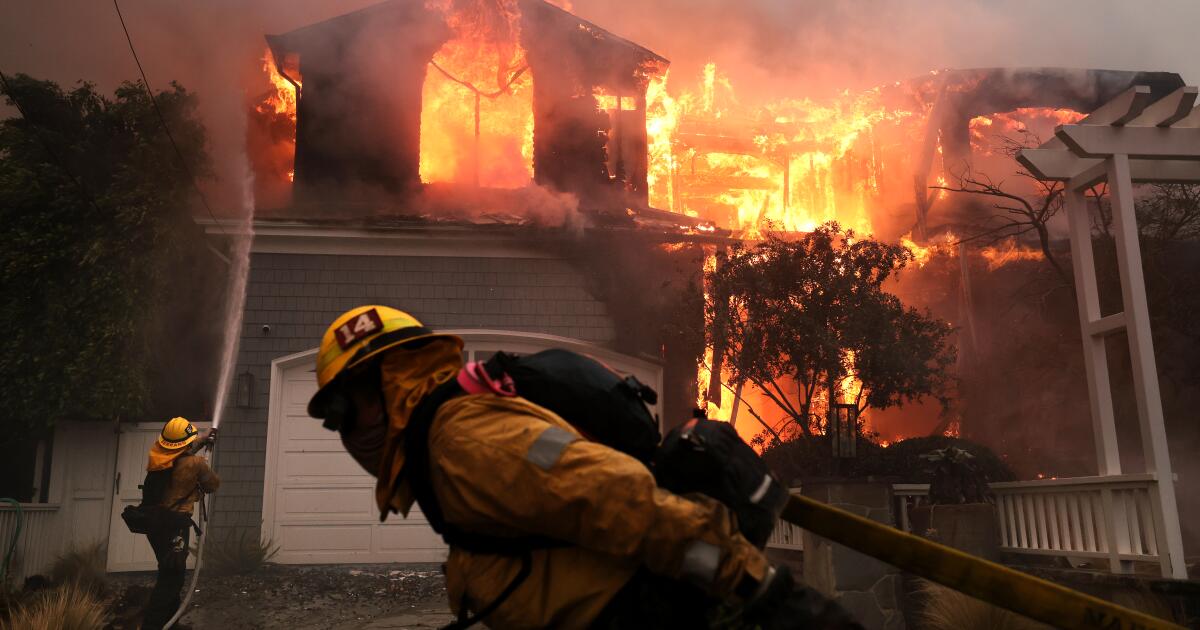Federal investigators have determined that the wildfire that leveled much of Pacific Palisades on Jan. 7 was a so-called “holdover” from a smaller fire that was set intentionally on New Year’s Day, about a week earlier.
After Los Angeles firefighters suppressed the Jan. 1 fire known as the Lachman fire, it continued to smolder and burn underground, “unbeknownst to anyone,” according to federal officials. They said heavy winds six days later caused the underground fire to surface and spread above ground in what became one of the costliest and most destructive disasters in city history.
The revelations — unveiled in a criminal complaint and attached affidavit Wednesday charging the alleged arsonist, Jonathan Rinderknecht — raise questions about what the Los Angeles Fire Department could have done to prevent the conflagration in the days leading up to the expected windstorm on Jan. 7 and the extraordinary fire risk that would come with it.
“This affidavit puts the responsibility on the fire department,” said Ed Nordskog, former head of the Los Angeles County Sheriff’s Department’s arson unit. “There needs to be a commission examining why this rekindled fire was allowed to reignite.”
He added: “The arsonist set the first fire, but the Fire Department proactively has a duty to do certain things.”
A Times investigation found that LAFD officials did not pre-deploy any engines to the Palisades ahead of the Jan. 7 fire, despite warnings about extreme weather. In preparing for the winds, the department staffed up only five of more than 40 engines available to supplement the regular firefighting force.
Those engines could have been pre-positioned in the Palisades and elsewhere, as had been done in the past during similar weather.
Kenny Cooper, special agent in charge of the Bureau of Alcohol, Tobacco, Firearms and Explosives who was involved in the investigation into the Palisades fire’s origin, said the blame for the fire’s re-ignition lies solely with the person who started it.
“That fire burned deep within the ground, in roots and in structure, and remained active for several days,” Cooper said. “No matter how good they are, they can’t see that, right?”
But, he said, wildland firefighters commonly patrol for days or weeks to prevent re-ignitions.
When he worked at a state forestry agency, he said, “we would have a lightning strike, and it would hit a tree, and it would burn for days, sometimes weeks, and then ignite into a forest fire. We would go suppress that, and then every day, for weeks on end, we would patrol those areas to make sure they didn’t reignite,” he said. “If we saw evidence of smoke or heat, then we would provide resources to that. So that, I know that’s a common practice, and it’s just, it’s a very difficult fire burning underground.”
The affidavit provides a window into the firefighting timeline on Jan. 1, when just after midnight, the Lachman fire was ignited near a small clearing near the Temescal Ridge Trail.
12:13 a.m.: An image taken from a UCSD camera, approximately two-tenths of a mile away, shows a bright spot in the upper left — the Lachman fire.
12:20 a.m.: Rinderknecht drives down Palisades Drive, passing fire engines heading up Palisades Drive, responding to the fire.
That night, the LAFD, with help from the Los Angeles County Fire Department, used water drops from aircraft and hose lines, as well as handlines dug by L.A. County crews, to attack the fire, according to the complaint. Firefighters continued suppression efforts during the day on Jan. 1, wetting down areas within the fire perimeter. When the suppression efforts were over, the affidavit said, the fire crews left fire hoses on site, in case they needed to be redeployed.
Jan. 2: LAFD personnel returned to the scene to collect the fire hoses. According to the affidavit, it appeared to them that the fire was fully extinguished.
But investigators determined that during the Lachman fire, a firebrand became seated within the dense vegetation, continuing to smolder and burn within the roots underground. Strong winds brought the embers to the surface, to grow into a deadly conflagration.
